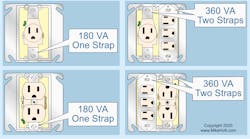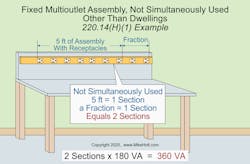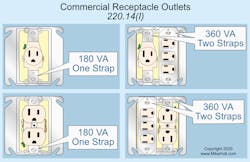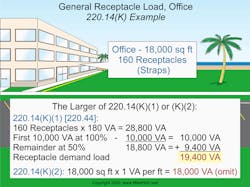Based on the 2020 National Electrical Code.
Article 220 of the 2020 National Electrical Code (NEC) contains the requirements for calculating demand loads for branch circuits, feeders, and services. Table 220.3 lists references for branch-circuit calculations for specific equipment in Chapter 4.
Calculate your branch-circuit, feeder, and service loads using nominal system voltages, (e.g., 120V, 120/240V, 120/208V, 240V, 277/480V, 480V) unless other voltages are specified [Sec. 220.5(A)].
What if you do a calculation and get a fraction of an amp? You can round the answer to the nearest whole number, with decimal fractions smaller than 0.50 dropped [Sec. 220.5(B)].
Calculate the floor area from the outside dimensions of the building, dwelling unit, or other area involved [Sec. 220.11]. For dwelling units, the calculated floor area does not include open porches, garages, or unused or unfinished spaces not adaptable for future use.
Lighting Load for Non-Dwelling Occupancies
The general lighting load specified in Table 220.12 for non-dwelling occupancies and the floor area determined per Sec. 220.11 must be used to calculate the minimum lighting load [Sec. 220.12(A)]. When using the unit loads in Table 220.12 for calculating the minimum lighting load for a specified occupancy, never add the 125% multiplier for a continuous load [Note 1 to Table 220.12].
Where the building is designed and constructed to comply with an energy code adopted by the local authority, you can calculate the lighting load using the unit values specified in the energy code [Sec. 220.12(B)]. In order to do so, however, these conditions must be met:
(1) A power monitoring system provides continuous information about the total general lighting load of the building.
(2) The power monitoring system is set with alarm values to alert the building owner or manager if the lighting load exceeds the values set by the energy code. Automatic means are allowed to reduce the connected load.
(3) The demand factors specified in Sec. 220.42 are not applied to the general lighting load.
(4) The continuous load multiplier of 125% is applied.
What to do with some occupancies might be confusing. The Notes to Table 220.12 provide some clarity with this list:
a. Armories and auditoriums are considered gymnasium-type occupancies.
b. Lodge rooms are like hotels and motels.
c. Industrial commercial loft buildings are considered manufacturing-type occupancies.
d. Banks are office-type occupancies.
e. Garages — commercial (storage) are considered parking garage occupancies.
f. Clubs are considered restaurant occupancies.
g. Barber shops and beauty parlors are considered retail occupancies.
h. Stores are considered retail occupancies.
Other Loads in Occupancies
You’ll find requirements for various types of loads in Sec. 220.14(A) through (M). Following are some highlights from that section:
(D) Calculate the branch-circuit VA load for luminaires based on the maximum VA rating of the luminaires.
(F) Each commercial occupancy accessible to pedestrians must have at least one 20A sign outlet [Sec. 600.5(A)] with a minimum branch-circuit load of 1,200VA or the actual VA if larger.
(G) The branch-circuit VA load for show-window lighting must be calculated per (1) or (2):
(1) 180VA for each show-window lighting outlet per Sec. 220.14(L).
(2) 200VA for each linear foot of show window [Sec. 220.43].
(H) Fixed multioutlet assemblies in commercial occupancies must be calculated per (1) or (2):
(1) If appliances are unlikely to be used simultaneously, each 5 ft or fraction of 5 ft of multioutlet assembly is considered 180VA (Fig. 1).
(2) If appliances are likely to be used simultaneously, each 1 ft or fraction of a ft of multioutlet assembly is considered 180VA.
(I) In commercial occupancies, each 15A or 20A, 125V general-use receptacle outlet is considered 180VA per mounting strap for each, except as covered in Sec. 210.14(J) and (K), as shown in Fig. 2.
(J) In one-family, two-family, and multifamily dwellings, the minimum unit load is 3VA per sq ft. The lighting and receptacle outlets specified in Sec. 220.14(J)(1), (J)(2), and (J)(3) are included in the 3VA per sq ft.
(1) General-use receptacle outlets of 20A rating or less, including receptacles connected to the bathroom or garage circuits in accordance with 210.11(C)(3) and 210.11(C)(4).
(2) Receptacle outlets specified in Sec. 210.52(E) and (G) for outdoor, garage, and basements.
(3) Lighting outlets specified in Sec. 210.70.
No additional load calculations are required for such outlets. Determine the minimum lighting load by using the 3VA per sq ft unit load and the floor area as determined in Sec. 220.11.
There is no VA load for 15A and 20A, 125V general-use receptacle outlets because the loads for those devices are part of the 3VA per sq foot for general lighting contained in Table Sec. 220.14(J) for dwelling units.
Although there is no limit on the number of receptacles on dwelling unit general-purpose branch circuits, the Code does require a minimum number of circuits for general-purpose receptacle and lighting outlets [Sec. 210.11(A)]. Also, the receptacle and lighting loads must be evenly distributed among the appropriate number of circuits [Sec. 210.11(B)].
(K) The calculated load for receptacle outlets in office buildings is based on the larger calculation of (1) or (2).
(1) The receptacle outlet load at 180VA per receptacle yoke [Sec. 220.14(I)] after all demand factors have been applied.
(2) The receptacle outlet load at 1VA per sq ft.
Let’s run through an example problem to show you how this works.
Question: What is the calculated receptacle load for an 18,000-sq-ft office space with one hundred sixty 15A, 125V receptacles (Fig. 3)?
Solution: The first calculation is based on Sec. 220.14(K)(1) and Sec. 220.14(I).
160 Receptacles × 180VA = 28,800VA
First 10,000VA at 100% = 10,000VA × 100% = 10,000VA
Remainder at 50% = 18,800VA × 50% = 9,400VA
Receptacle Calculated Demand Load = 19,400VA
The second calculation is based on Sec. 220.14(K)(2).
18,000 × 1VA per sq ft = 18,000VA
Answer: Using the larger of the two results, the answer is 19,400VA.
(L) 180VA for each receptacle and lighting outlet not covered in (A) through (K).
(M) In guest rooms or guest suites of hotels and motels, the lighting and receptacle outlets specified in Sec. 220.14(M)(1), (M)(2), and (M)(3) are included in the 1.70VA per sq ft unit load in Table 220.12:
(1) General-use receptacle outlets of 20A rating or less, including receptacles connected to the bathroom or garage circuits per 210.11(C)(3) and 210.11(C)(4).
(2) Receptacle outlets specified in Sec. 210.52(E)(3) for balconies, decks, and porches.
(3) Lighting outlets specified in Sec. 210.70.
No additional load calculations are required for such outlets. The minimum lighting load is to be determined using the 1.70VA per sq ft unit load and the floor area as determined in Sec. 220.11.
Maximum Loads
Where a circuit supplies only a motor, the conductor and the overcurrent protection are sized per Art. 430 [Sec. 220.18(A)]. Where a circuit supplies only air-conditioning equipment, Art. 440 applies.
Branch circuits that supply inductive and LED driver lighting loads must be sized to the ampere rating of the luminaire, not to the wattage of the lamps. [Sec. 220.18(B)].
You can apply demand factors to range loads, per Table 220.55 [Sec. 220.18(C)].
Eliminating Errors
The rules for lighting load calculations vary by occupancy type. Remember that any given area served by a branch circuit can be a different kind of occupancy from the building in which it’s located (for example, a gym within a police station).
Review your completed calculations to ensure you have included the applicable demand factors and continuous load multipliers. Omissions here are responsible for most branch-circuit calculation errors.
Next month we'll take a look at feeder and service load calculations in Part 2 of this two-part series.
These materials are provided to us by Mike Holt Enterprises in Leesburg, Fla. To view Code training materials offered by this company, visit www.mikeholt.com/code.








